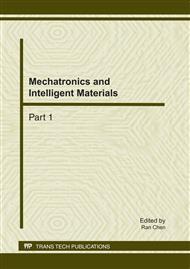[1]
H. -C. Liu, J. -M. Yih, W. -C. Lin and D. -B. Wu: Journal of Multiple Valued Logic & Soft Computing, 15 (2009), pp.581-595.
Google Scholar
[2]
G. J. Klir, and B. Yuan, Fuzzy Sets and Fuzzy Logic: Theory and Applications, Prentice-Hall, New York, NY, (1995).
Google Scholar
[3]
L. A. Zadeh, Fuzzy sets, Information and Control, 1965, Vol. 8, pp.338-353.
Google Scholar
[4]
R. Coppi, P. Giordani and P. D'Urso, Component Models for Fuzzy Data, Psychometrika, Vol. 71, 2006, pp.733-761.
DOI: 10.1007/s11336-003-1105-1
Google Scholar
[5]
Y. H. Lin, W. M. Bart and K. J. Huang: WPIRS Software [Manual and Sftware for Gneralized Soring of Item Relational Structure] (2006).
Google Scholar
[6]
Y. H. Lin, M. W. Bart, and K. J. Huang, Generalized Polytomous Ordering Theory [manual and software], National Taichung University, Taiwan, (2006).
Google Scholar
[7]
T. Sato, Introduction to S-P Curve Theory Analysis and Evaluation, Tokyo, Meiji Tosho, (1985).
Google Scholar
[8]
L. F. Blixt, and T.E. Dinero, An Initial Book Look at The Validity of Diagnoses Based on Sato's Caution Index, Education and Psychological Measurement, Vol. 45, 1985, pp.55-61. T.
DOI: 10.1177/001316448504500213
Google Scholar
[9]
R. Coppi, P. Giordani and P. D'Urso (2006), Component models for fuzzy data, Psychometrika, vol. 71, pp.733-761.
DOI: 10.1007/s11336-003-1105-1
Google Scholar
[10]
T. Sato, The S-P Chart and The Caution Index, NEC Educational Information Bulletin 80-1, C&C Systems Research Laboratories, Nippon Electic Co., Ltd,. Tokyo, Japan, (1980).
Google Scholar
[11]
U. Bodenhofer, A Similarity-Based Generalization of Fuzzy Orderings Preserving the Classical Axioms, Fuzziness Knowledge- Based Systems, Vol. 8, 2000, pp.593-610.
DOI: 10.1142/s0218488500000411
Google Scholar
[12]
T. Sato, Introduction to S-P Curve Theory Analysis and Evaluation, Tokyo, Meiji Tosho, (1985).
Google Scholar
[13]
K. K. Tatsuoka, and M. M. Tatsuoka, Computerized Cognitive Diagnostic Adaptive Testing: Effect on Remedial Instruction as Empirical Validation, Journal of Educational Measurement, Vol. 34, 1997, pp.3-20.
DOI: 10.1111/j.1745-3984.1997.tb00504.x
Google Scholar
[14]
Y. H. Lin, and S. M. Chen, The Integrated Analysis of S-P Chart and Ordering Theory on Equality Axiom Concepts Test for Sixth Graders, WSEAS Transactions on Mathematics, Vol. 5, 2006, pp.1303-1308.
Google Scholar
[15]
K. Tatsuka, and M. Tatsuoka, Spotting Erroneous Rules of Operation by The Individual Consistency Index, Journal of Education Measurement, Vol. 20, 1983, pp.221-230.
DOI: 10.1111/j.1745-3984.1983.tb00201.x
Google Scholar
[16]
D. J. Chen, A. F. Lai, and I. C. Liu, The Design and Implementation of a Diagnostic Test System Based on the Enhanced S-P Model, Journal of Information Science and Engineering, Vol. 21, 2005, pp.1007-1030.
Google Scholar


